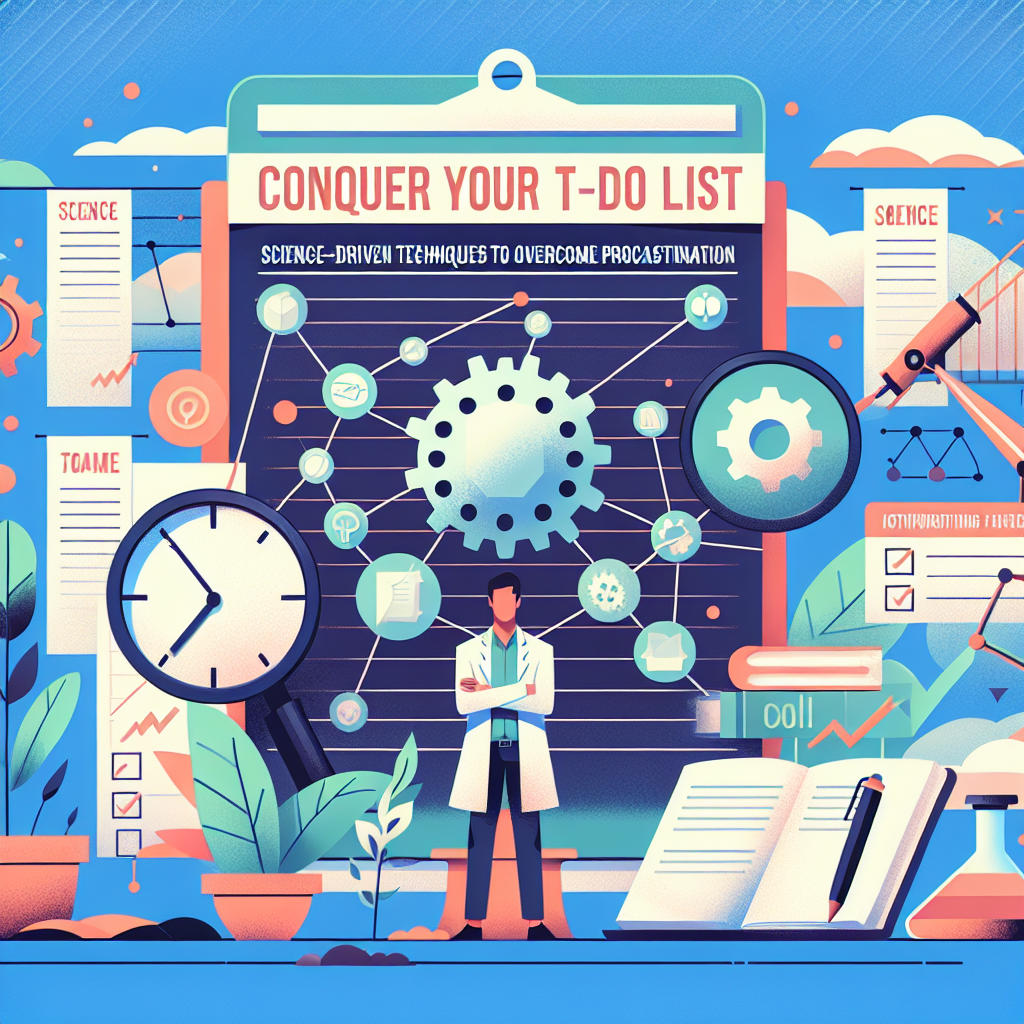
Conquer Your To-Do List: Proven Science-Driven Techniques to Overcome Procrastination
Introduction
We’ve all been there: a looming deadline, a long list of tasks, and yet, all we seem to do is scroll mindlessly through our phones or binge-watch another series. Procrastination is all too common, but it doesn’t have to dictate our lives. With the right strategies, you can conquer your to-do list and reclaim your productivity. This article dives deep into science-driven techniques to overcome procrastination, ensuring that you not only manage your time effectively but also feel accomplished and satisfied in the process.
Understanding Procrastination
What is Procrastination?
Procrastination isn’t just a simple delay in task completion—it’s a complex emotional and psychological issue. Defined as the act of delaying or postponing a task, procrastination often arises from fear of failure, perfectionism, or even a lack of motivation. Research indicates that about 20% of adults consider themselves chronic procrastinators. Understanding the roots of procrastination is essential to conquering it effectively.
The Emotional Impact of Procrastination
Many individuals experience a cycle of guilt and anxiety due to procrastination. This emotional toll can lead to decreased productivity and undermine mental well-being. Studies show that those who procrastinate often experience higher levels of stress and lower self-esteem. Recognizing the emotional consequences of procrastination is the first step toward losing its grip on your life.
Techniques to Overcome Procrastination
1. Break It Down: The Power of Micro-Tasks
One effective way to conquer your to-do list is by breaking larger tasks into smaller, manageable micro-tasks. Research highlights that individuals are more likely to complete tasks when they feel a sense of progress, no matter how small.
Case Study: The Pomodoro Technique
A well-known productivity method, the Pomodoro Technique, promotes breaking work into focused intervals (usually 25 minutes), followed by short breaks. This approach not only combats procrastination but also enhances concentration. By dividing a task into steps and focusing solely on one at a time, you mitigate overwhelm and increase your chances of completion.
| Task | Micro-Tasks | Time Allocated |
|---|---|---|
| Write a report | Research topic, draft outline, write introduction | 25 minutes each |
| Prepare for a presentation | Create slides, rehearse points, gather materials | 30 minutes each |
2. Time Blocking: Design Your Day
Time blocking is a powerful technique that involves scheduling specific time slots for tasks throughout your day. Miriam Ellison, a productivity expert, states that when your schedule is managed effectively, distractions are minimized, and your focus is amplified.
Case Study: Elon Musk
Elon Musk is known for his intense time management skills. He is an advocate for time blocking, often dedicating specific hours for meetings, creative time, and work on individual tasks. This method helps him prioritize essential tasks and maintain high productivity.
3. The 5-Minute Rule
Sometimes, simply getting started is the hardest part. By acknowledging this mental barrier, you can leverage the 5-Minute Rule, which encourages you to commit to a task for just five minutes. Once you begin, it’s often easier to continue.
Case Study: The Writer’s Block
Many famous writers, including Ernest Hemingway and Neil Gaiman, have spoken about the importance of just putting pen to paper. The 5-Minute Rule aligns perfectly with their advice, allowing writers to overcome blocks and procrastination, ultimately leading to greater productivity.
4. Accountability Partners: Share Your Goals
Having someone to hold you accountable can significantly reduce procrastination. Sharing your goals with an accountability partner can motivate you to stay on track, as they provide support, encouragement, and check-ins.
Case Study: The Buddy System in Fitness
Many fitness enthusiasts use an accountability system to stay committed to their workout regimes. Research indicates that those who share fitness goals with friends are more likely to stick to them. This principle applies well to managing your to-do list; accountability partners can help you conquer procrastination by checking on your progress.
5. Understanding Your Motivation through the Eisenhower Matrix
The Eisenhower Matrix categorizes tasks into four quadrants based on urgency and importance. This visual tool can guide you in prioritizing tasks and ensuring that you focus on what truly matters.
Case Study: General Dwight D. Eisenhower
The matrix itself is named after General Dwight D. Eisenhower, who famously made decisions based on urgency and importance. Utilizing this strategy enables you to eliminate tasks that aren’t worth your time, thus helping you conquer your to-do list.
| Urgent & Important | Not Urgent & Important | Urgent & Not Important | Not Urgent & Not Important |
|---|---|---|---|
| Crisis Management | Long-term Goals | Interruptions | Time Wasters |
| Projects | Planning | Some Meetings | Social Media Scrolling |
Motivation and Mindset Shifts
Cultivating a Growth Mindset
Fostering a growth mindset is vital when battling procrastination. Carol Dweck’s research suggests that individuals who adopt a growth mindset are more resilient and open to learning from their failures, making it easier to take action and push through challenges.
Affirmations and Positive Reinforcement
Incorporating affirmations into your daily routine can reinforce a positive mindset and enhance your motivation. Affirmations like “I am capable of completing my tasks” can shift your thinking from self-doubt to self-empowerment. Research shows that positive reinforcement effectively combats feelings of procrastination, creating a healthier mental state.
Visualization: See Your Success
Visualization is a powerful technique athletes often use to enhance their performance, and it can work wonders in overcoming procrastination as well. Imagine yourself completing your tasks with ease and enjoying the satisfaction that comes with achievement. This technique sets a positive tone and motivates you to take action.
Conclusion
Conquering procrastination is not just about managing your time; it’s about transforming your mindset and adopting science-backed strategies that can help you overcome the paralysis of inaction. By breaking tasks into micro-steps, utilizing accountability partners, and cultivating a growth mindset, you will not only conquer your to-do list but also unlock a new level of productivity and satisfaction in your daily life.
Actionable Insights
- Implement Time Blocking: Schedule dedicated time slots for your tasks to maximize focus.
- Utilize the Pomodoro Technique: Break tasks into intervals to maintain energy and concentration.
- Adopt Positive Affirmations: Use daily affirmations to reinforce a successful mindset.
FAQs
1. Why do people procrastinate?
Procrastination often stems from fear of failure, perfectionism, or lack of motivation. Recognizing the emotional triggers behind procrastination is crucial in addressing the issue effectively.
2. How can I stay accountable?
Find an accountability partner, join study groups, or use productivity apps that send reminders and track your progress to keep you aligned with your goals.
3. What techniques are most effective for overcoming procrastination?
Techniques such as breaking tasks into micro-tasks, using time blocking, and establishing accountability systems are proven to reduce procrastination and improve productivity.
4. Can visualization really help with procrastination?
Yes! Visualization can enhance motivation and create a positive mindset, making it easier to start and complete tasks on your to-do list.
5. How often should I reassess my to-do list?
Reassessing your to-do list regularly, at least weekly, can help you prioritize tasks effectively and make adjustments based on changing needs and deadlines.
In this journey towards productivity, remember: conquering your to-do list is not just about finishing tasks; it’s about mastering the art of taking action, understanding your motivations, and celebrating your progress along the way. You have the tools at your disposal—now, seize the day and conquer your to-do list!













